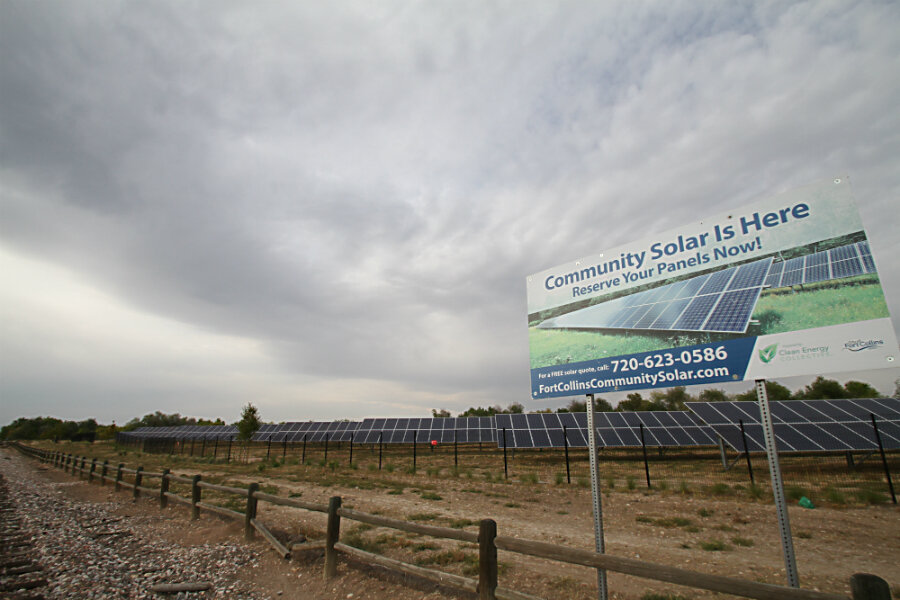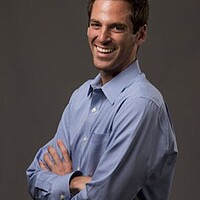Panels to the people: 'Community solar' aims to democratize the sun
Loading...
| Washington
Dant’e King is selling sunshine and potential.
The former nuclear-plant worker is priming residents of Baltimore and Washington on a different kind of power: “community solar.” The idea is to allow people to go solar even if they don’t have a lot of money or a rooftop of their own.
Mr. King has hit the pavement in low- and middle-income communities – regularly popping up at neighborhood association meetings and churches – to spread the gospel about community solar.
“I don’t think it’s a matter of whether it’s too expensive or not. I think the misperception is that it’s exclusive,” says King, who is director of community outreach for Groundswell, which is seeking to connect customers with a growing number of developers in this nascent slice of America’s solar industry. He is also senior pastor at a Maryland church – and sees his power-to-the-people effort as flowing from a deeper sense of duty to the planet.
No longer will solar be for the “white yuppies,” as King (politely prefaced with a “no offense” warning) puts it.
In one new project Groundswell is participating in, a large Washington church is creating a solar-paneled canopy for its parking lot. The resulting power will flow on to the local electric grid and then be purchased by about 150 ratepayers who are seeking clean energy. Groundswell anticipates the deal will cut electricity costs at least 10 percent for low- or moderate-income subscribers.
That’s one example of the egalitarian vision of community solar, which can take a variety of forms across the country. Sometimes residents band together in cooperatives or similar setups, pooling their resources to create an array of solar panels in a centralized location. The credit-score limits for participating are thought to be less restrictive than for self-financing an individual rooftop solar system, so advocates believe people of modest means will be able to afford community solar.
Although the grand vision is not coming to fruition quickly – partly because financiers are still skeptical – King says he’s unfazed.
“Everything is in its infancy stage” with community solar, King says. He says there are definitely potential customers waiting. “I haven’t met anyone who has a negative response about it or doesn’t want to know more about it.”
Big potential
Seeing untapped urban and rural low-income communities, analysts project huge increases for community solar from the 100 megawatts currently operating nationwide. The National Renewable Energy Laboratory (NREL), for example, has estimated community solar could account for half of all distributed solar power in the US by 2030. In the near-term, it expects growth ranging between 5.5 to 11 gigawatts between 2015 and 2020, accounting for $8.2 to $16.3 billion of investment.
As costs for solar equipment have declined, community solar may occupy a kind of sweet spot. Proponents say it could attract more financiers and investors than individual rooftop installations. At the same time, it's less capital-intensive than major endeavors that have sprouted in some desert states, where thousands of panels combine into the equivalent of a power plant for the local grid.
“You look at just the rate of growth in solar in the last three or four years, this is an element that’s growing within that rate,” says Richard McMahon, vice president of energy supply and finance with the Edison Electric Institute, a trade organization that represents investor-owned utilities.
Fourteen states plus the District of Columbia have a community solar policy, though specifics vary, making project planning easier in some states than others. Several state legislatures are entertaining bills to expand or better define community solar.
Utilities are in on the business. More than 90 have a community solar operation, according to Mr. McMahon. Power companies like the model because they can place projects where they’re most needed to meet electricity demand, helping reduce system strain.
Other players are third-party developers.
“It really provides an opportunity to customers who can’t have solar on their home,” says Betty Watson, deputy director of policy and electricity markets with SolarCity. “It creates more equity among distributed generation customers because it gives everyone the opportunity to participate in those programs.”
That’s true in theory, but it hasn’t been in practice so far, says Isaac Baker, vice president of community solar for Co-Op Power and founder of Resonant Energy, which focuses on bringing solar to low-income residents.
He says community solar developers have still proven unwilling to take on people with low credit scores, similar to rooftop installations. Some fear remains that customers with credit risk will fall behind on payments.
How to widen the market?
Massachusetts, where Baker works, is now planning to give developers some extra money for inking low-income customers. Colorado requires that 5 percent of community solar projects go to low-income residents. And Xcel Energy, a utility, is exploring pilot programs to boost low-income subscribers in Minnesota.
“We don’t have the silver bullet today. Many areas of the country are struggling with the same thing,” says Lee Gabler, director of customer strategy and solutions with Xcel, which operates community solar in Colorado, Minnesota, and Wisconsin. He pinned part of the problem on third-party financiers’ credit score requirements that keep low-income residents out of the market.
In rural areas, residents of low or modest incomes have been quicker to adopt community solar. Usually served by “cooperatives” with elected board members in small communities, they like the idea that the power is locally owned.
“In most of these markets, at least so far, the cooperatives they’re extremely nimble, extremely interested,” said Kieran Coleman of the Rocky Mountain Institute, who has a program working to introduce community solar at cooperatives in New Mexico, Minnesota, New York, North Carolina, Texas, and Colorado.
Back in Maryland, King is hard at work, talking to people “who have the pulse of the community” and educating. People stick with their utility companies because they’re “creatures of habit,” he says. And most he talks to haven’t thought about solar because they always thought it was too expensive.
“To re-educate that person – it’s a culture change,” he says.








